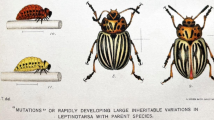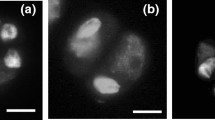IV. Summary
-
1.
In hybrids between BritishTephrosia bistortata and melanic ContinentalT. crepuscularia the melanism behaves in inheritance as an ordinary Mendelian dominant.
-
2.
This is unlike the state of affairs when the melanism is introduced by BritishT. crepuscularia var.delamerensis; then the melanism degenerates.
-
3.
In spite of the fact that ContinentalT. crepuscularia is bivoltine the aberrant sex ratios observed in the crosses involving the univoltine British insect still persist.
-
4.
As in the case of the same crosspairing when both species are of British origin, in the present crosses certain F1 hybrid females of parentagecrepuscularia female ×bistortata male deposited eggs developing parthenogenetically.
-
5.
This yields experimental proof ofErnst's proposition that apogamy (parthenogenesis) owes its induction to hybridity.
Similar content being viewed by others
V. Literature quoted
Blackburn, K. B., andHarrison, J. W. Heslop (1921). “The Status of the British Rose Forms as determined by their Cytological Behaviour.”Ann. Bot. Vol. 35.
Dingler, H. (1906). “Fakultative parthenogenetische Fortpflanzung beiRosa rubiginosa” Mitt. Nat. Ver. Aschaffenburg. Bd. 5.
Ernst, A. (1918).Bastardierung als Ursache der Apogamie im Pflanzenreiche, Jena.
Goldschmidt, R. (1917). “On a Case of Facultative Parthenogenesis in the Gipsy Moth”.Biol. Bull. Vol. 33.
Harrison, J. W. Heslop. (1920a). “The Inheritance of Melanism in the GenusTephrosia (Ectropis)”.Journ. Genet. Vol. 10.
Harrison, J. W. Heslop. (1920b). “The Genus Rosa, its Hybridology and other Genetical Problems”.Trans. Nat. Hist. Soc., Northumberland and Durham. N. S. Vol. 5.
Harrison, J. W. Heslop. (1923). “The Inheritance of Wing Colour and Pattern in the Lepidopterous GenusTephrosia (Ectropis).” I.Journ. Genet. Vol. 13.
Harrison, J. W. Heslop. (1926). “Miscellaneous Observations on the Induction, Incidence and Inheritance of Melanism in the Lepidoptera.”Entomologist. Vol. 59.
Harrison, J. W. Heslop, andPeacock, A. D. (1925). “On Parthenogenesis originating in Lepidopterous Crosses.”Trans. Nat. Hist. Soc. Northumberland and Durham. N. S. Vol. 6.
Lundström, E. (1909). “Kastreringsforsök med Rosa-former.”Svensk. Bot. Tidskr. Bd. 3.
Nabours, K. (1925). Studies in Inheritance and Evolution in Orthoptera, V. The Grouse LocustApottetix eurycephalus, Hancock.”Tech. Bull. 17. Kansas State. Agr. Exp. Stn.
Ostenfeld, C. H. (1910). Further Studies on the Apogamy and Hybridisation of theHieracia.”Zeitschr. ind. Abst. und Vererbungslehre. Bd. 3.
Ostenfeld, C. H. (1912). Experiments on the Origin of Species in the GenusHieracium (Apogamy and Hybridism).”New Phytol. Vol. II.
Peacock, A. D. (1925). “Animal Parthenogenesis in Relation to Chromosomes and Species”.Amer. Nat. Vol. 59.
Peacock, A. D., andHarrison, J. W. Heslop (1926). “Hybridity, Parthenogenesis and Segregation.”Nature. Vol. 117.
Rosenberg, O. (1909). “Ueber die Chromosomenzahlen beiTaraxacum undRosa. Svensk. Bot. Tidskr. Bd. 3.
Rosenberg, O. (1917). “Die Reduktionsteilung und ihre Degeneration inHieracium.”Svensk. Bot. Tidskr. Bd. 14.
Täckholm, G. (1922). “Zytologische Studien über die GattungRosa.”Acta Hort. Berg. Bd. 7.
Author information
Authors and Affiliations
Rights and permissions
About this article
Cite this article
Heslop Harrison, J.W. The inheritance of melanism in hybrids between continental Tephrosia crepuscularia and british T. Bistortata, with some remarks on the origin of parthenogenesis in interspecific crosses. Genetica 9, 467–480 (1927). https://doi.org/10.1007/BF01508298
Received:
Issue Date:
DOI: https://doi.org/10.1007/BF01508298




